Areas: Koshigoe (腰越) and Tsu (津)
Place Name
KoshigoeThere are several theories regarding the origin of the name Koshigoe. One of them, found in the Shimpen Sagaminokuni Fudokiko (新編相模国風土記稿, an old book about the Sagami area), states that the mountains ranged higher in the north and lower toward the sea in the south. In the lower area there was a tract of fertile land, enticing people to cross over the mountain for a better life. The word koshi means “the lower part of a mountain," and goe means "to go over." Koshigoe therefore means "to cross the lower part of a mountain."
Tsumura
The word "tsu" (津) in Tsumura supposedly derived from the verb tsudou (to gather) and came to mean "a gathering of ships," particularly in reference to a port. A good example is the port city of Tsu in Mie Prefecture. The area was once partially submerged and its many inlets must have seen a great deal of ship traffic.
Another explanation of the name says that this area was a rounded knoll of land, a shape called tsubura (円, round). This word evolved into Tsumura, first written with these Chinese characters 積良. Eventually they were replaced by these Chinese characters 津村, although the pronunciation remained the same.
| Mampukuji Temple (万福寺) |
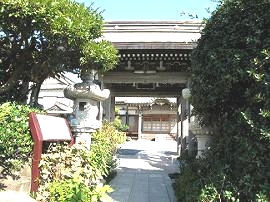
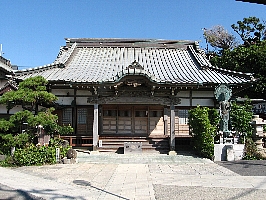
Full name: Ryugosan (龍護山) Mampukuji
Denomination: Shingon sect (真言宗)
Location: The temple is located near Koshigoe Station on the Enoden Line.
History: The founder was the celebrated priest, Gyoki (行基, 668-749). Temple legend explains that in the eighth century (Nara period), a deadly disease spread throughout the Kanto region, killing many people. Emperor Shomu (聖武天皇, 701-756), alarmed about the situation, asked Gyoki to go to Kanto to end the epidemic.
Once here, the sight of the blue sea and the green hills so inspired Gyoki that he thought it an ideal place to pray for victory over the disease, and immediately set about carving three statues: one of Yakushi Nyorai (薬師如来), one of Nikko Bosatsu (日光菩薩), and one of Gakko Bosatsu (月光菩薩). Upon completion, no sooner did he begin to pray than the sickness ended. To praise this blessing from Buddha, Gyoki then decided to build a temple, whose Main Hall now houses the statues.
The temple also boasts a legend associated with a letter by Minamoto no Yoshitsune (源義経, 1159-89), and his loyal follower, Benkei (弁慶, ?-1189).
The letter, sent to Shogun Minamoto no Yoritomo (源頼朝, 1147-99), Yoshitsune's elder brother, pleaded Yoshitsune's innocence in regard to a misunderstanding.
The estrangement between the two brothers had had its beginning in 1185 when Yoshitsune returned triumphantly from battle, bringing along Taira no Munemori (平宗盛, 1147-85) and his son as prisoners after having destroyed the Taira clan.
Yoritomo was not pleased to see his younger brother, for Yoshitsune had accepted a high rank at court in Kyoto without first obtaining his permission. Thus there was no welcome for Yoshitsune in Kamakura, and Yoritomo in fact denied him entry. Accordingly, Yoshitsune put up at Mampukuji Temple, from where he tried to appease Yoritomo's anger through the good offices of Wada Yoshimori (和田義盛, 1147-1213) and other influential vassals.
In due course he dispatched a letter to Oe no Hiromoto (大江広元, 1148-1225), the head of the Mandokoro (政所), the Administrative Board, seeking his help, but all his efforts came to naught. (In time, this letter came to be called Koshigoe-Jo (腰越状), or the Letter From Koshigoe.)
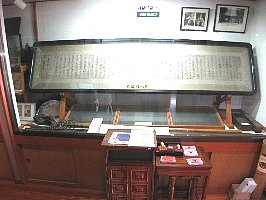
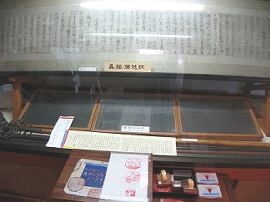
Yoshitsune was then compelled to leave Kamakura, and returned to Kyoto, where he soon raised a band of followers against Yoritomo, and sought the help of Fujiwara Hidehira (藤原秀衡, ?-1187) in Oshu (奥州). Following the death of this protector, Yoshitsune was attacked and killed by Yasuhira (泰衡, ?-1189), Hidehira's son, who had been pressured by Yoritomo to kill Yoshitsune.
Yoshitsune's head was sent back to Kamakura, where identification was made here in this temple. Wada Yoshimori and Kajiwara Kagetoki (梶原景時, ?-1200) were charged with the task.
Yoshimori, upon seeing the face, shed tears, and even Kagetoki it is said, was forced to look away.
Grounds: A Sammon Gate (山門) stands at the top of a flight of steps. Beyond it is the Main Hall in front and the Kuri (庫裏, priest's living quarters) to the left. The Main Hall, rebuilt in 1931, has three signboards: 「東国第八十四番」, 「相模国廿一霊場第十五番」, 「弘法大師廿一ケ所第十五番」.
The first means the 84th Stop on the Kanto Pilgrimage Circuit, the second refers to the 15th Spot of the 21 Scared Places in Sagami Province, and the third designates the 15th of Kobo Daishi's 21 Sacred Places.
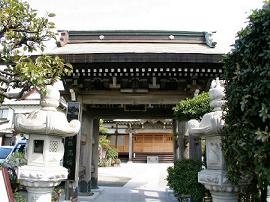
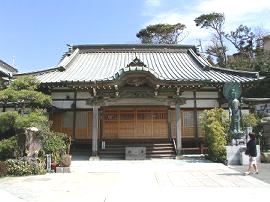
A belfry is to the left of the Sammon Gate, and a stone monument to commemorate Yoshitsune's sojourn is to the right. Further right is a small pond called Suzuri no Ike (硯の池), from which Yoshitsune's most loyal follower, Benkei, dipped water to make ink for writing the draft of the Letter from Koshigoe. At the rear right of the Main Hall is a well where Yoshitsune is said to have washed his hands while staying here.
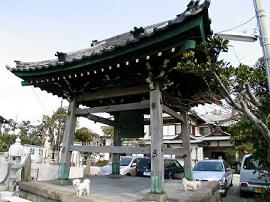
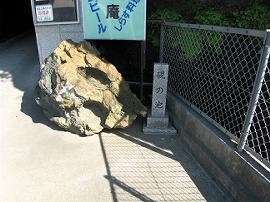
To the left from the Main Hall is a large stone called Benkei no Koshikake-ishi (弁慶の腰掛石), literally, 'Benkei Sat Here," but also called Tedama-ishi (手玉石), literally, Benkei's Juggling Stone. The monument nearby is in memory of the soul of Minamoto no Yoshitsune (源義経公慰霊碑).
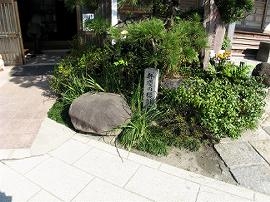
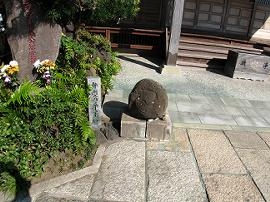
The temple houses a number of treasures. The objects displayed are an alleged draft of the famous letter that Yoshitsune dictated to Benkei, a set of Edo period wood-blocks for printing the letter, and a wooden cup and long staff used by Benkei himself.
The Main Hall has sixteen wooden sliding doors covered on both sides with colorful carvings that relate the story of Yoshitsune. The ceiling of Ihaido Hall (位牌堂), where mortuary tablets are kept, is covered with forty-eight colorful carvings of various kinds of flowers, all carved in the Kamakura-bori technique. These treasures are open to the public.
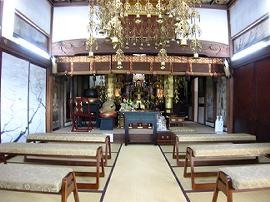
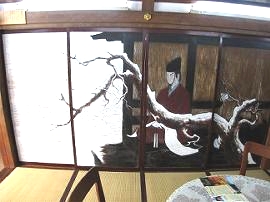
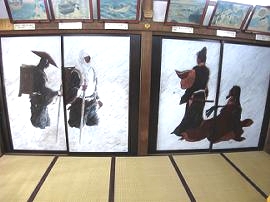
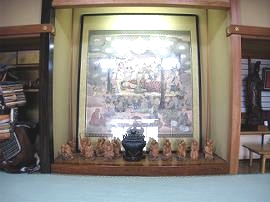
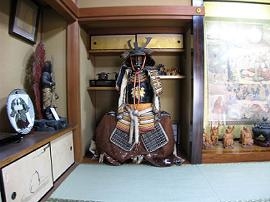
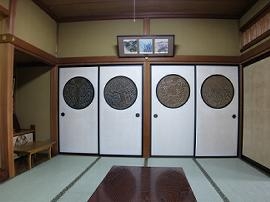
An annual festival for Yoshitsune is held in the middle of April, attracting many people who admire him and still have feelings of sympathy for him.
The Letter Sent to Yoritomo From Yoshitsune (extracted and paraphrased)
Minamoto no Yoshitsune respectfully states the following:
I was designated a Yoritomo deputy and an imperial messenger to overthrow the enemy of the imperial court, and did indeed destroy them and avenge the humiliating death of our father. For this I was expecting praise from my lord, but because of unfounded accusations against me I was instead harshly censored. I could do naught but weep in vain. The slander against me was not investigated, and I was prevented from meeting my lord to state my loyalty. Our fraternal tie seems useless and I ponder whether it must be the result of a sin in my previous life. Who, lest my father should reappear in this world, can help me explain my present circumstances? Since birth I have lived in constant danger, concealing myself in remote country places and serving even the lowly. On hearing of my brother's declaration of war against the Taira clan, I rushed to meet my lord. All I have done was done only to overthrow the Taira clan and to restore our own. The title I received, Constable of the Fifth Rank (五位の尉, goi-no-jo), is, I believe, an honor not only to me but also to our clan. I fear that but for the intervention of the gods and Buddha I shall be unable to convey my true intentions, for these attempts of mine have so far failed. None other than you can give them reality. I beg of you, your Excellency Governor of Inaba, to seek an opportunity to convey my pleas to my lord. Should pardon be granted, I will strive to the utmost of my abilities to work for the eternal prosperity of our clan and will spend the remainder of my life in peace.
Fifth Month, Second Year of Genryaku (元暦)
Minamoto no Yoshitsune
To the Governor of Inaba (因幡) (Oe no Hiromoto)
| Koyurugi Jinja Shrine (小動神社) |
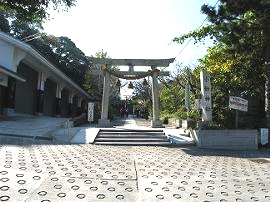
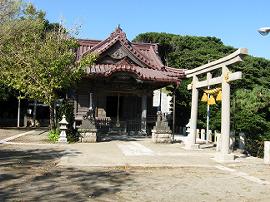
Location: The shrine is situated on the opposite side of Route 134 from Mampukuji Temple.
Grounds: The approach to the shrine lies beyond a myojin-style stone torii gate (明神鳥居). To its left is a guidepost relating the shrine's history. Another torii, in the same style as the first, is at the top of the stone steps. After passing through it, you see the shrine to the right. The halls were built in a style called gongen-zukuri (権現造り): two halls, one for worship, and a Main Hall, with the two halls being connected by a small room.
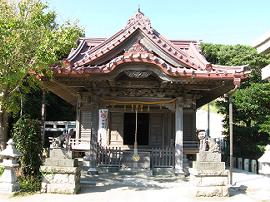
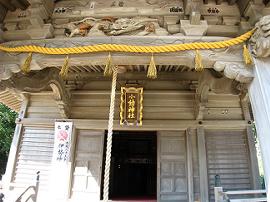
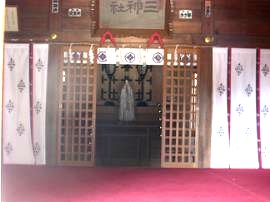
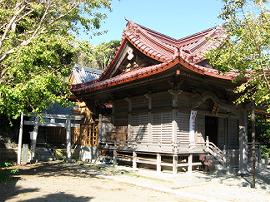
The shrine is the guardian god of Koshigoe, and covers the areas of Nakahara (中原), Shitamachi (下町), Dobashi (土橋), Godo (神戸), and Hamajo (浜上).
History It was built by Sasaki Moritsuna (佐々木盛綱, 1151-?), a warrior of the mid-twelfth century and a follower of Yoritomo.
When he passed through here on his way to Benzaiten (弁才天) on Enoshima in the 1180s, he was impressed by the natural beauty, especially the pine trees, and decided to build a shrine dedicated to Hachiojigu (八王子宮) in Omi (近江, present-day Shiga Prefecture). In those days, Moritsuna was an active participant in the battle between the Minamoto and the Taira, fighting under Minamoto no Noriyori (源範頼, ?-1193), a younger brother of Yoritomo.
The shrine is popularly called Hachioji no Miya and also Sanjinsha (三神社). The former refers to the five sons and three daughters of Susanoo no Mikoto (須佐之男命), and the latter to three gods: Gozu Tenno (牛頭天王, also Susanoo no Mikoto), Toshitokujin (歳徳神), and Yamatotakeru no Mikoto (日本武尊).
The present Main Hall was built in 1817 and the Front Hall in 1929. In 1868 the shrine's name was changed to Koyurugi Jinja due to the enforced separation of Shintoism and Buddhism. The shrine then became the tutelary shrine for this area. The grounds are sacred to Tateminakata no Kami (建御名方神), moved here from Suwa Jinja (諏訪神社). The observatory on the seaside offers a fine view of Enoshima, Izu and Hakone.
Festival The shrine's annual festival is held January 16, when Kamakura kagura (鎌倉神楽) is performed here. Another festival, Tenno Matsuri, is held from July 7 to 14. On the last day, the mikoshi (神輿), portable shrine, of Yasaka Jinja (八坂神社) on Enoshima Island is carried to Koshigoe in a procession accompanied by festival music called ryujin-bayashi, 龍人囃子, performed by local drummers. Processions from the five neighborhoods, this time with each playing festival music called tenno bayashi (天王囃子), noisily welcome the spirits of the gods. The festival is slowly regaining its former popularity. Warrior dolls displayed on the streets are another attraction of the festival.
| Koyurugi Misaki Cape (小動岬) |
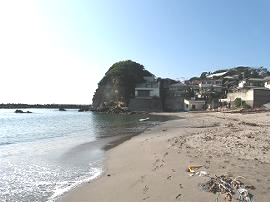
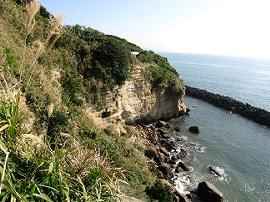
Koyurugi Misaki is the name of the cape where Koyurugi Jinja is located.
As a word, koyurugi (小動), means "quivering," and it is supposedly from this word that the area acquired its name, for the branches of a pine tree that once stood here reportedly made a melodious sound even when there was no wind to move them. Hearers envisioned heavenly maidens flitting playfully about the tree playing musical instruments, and dubbed the tree Koyurugi no Matsu (小動の松), “Quivering-Pine-Tree." The actual tree has long since died, and now only the name and the legend remain.
Others say a warrior by the name of Sasaki Moritsuna noticed this tree and named it. Still others contend that there a large boulder was here but was so unsteady it could easily be "rocked" by hand.
| Josenji Temple (浄泉寺) |
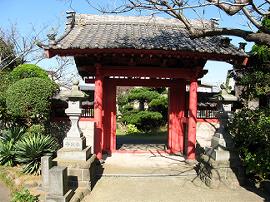
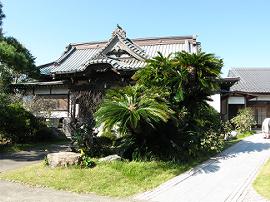
Full name: Koyurugisan (小動山) Josenji Temple (浄泉寺)
Denomination:Shingon sect (真言宗)
LOcation:Located north of Koyurugi Shrine across Route 134
Kobo Daishi (弘法大師, 774-835) is obscurely referred to as the founding priest, and the restorer is Genshu (元秀), who died in 1558.
History and Grounds: Upon passing through the vermilion gate of the shrine, you will see the Main Hall ahead. The chief image inside is a statue of Fudo Myoo. A nearby monument is inscribed 相模廿一ケ所第十六番, The 16th Spot of the 21 Scared Places in Sagami Province.
In the Meiji period there was a temple school here, called Hatsumo Gakusha (発蒙学舎) which was the predecessor of present-day Koshigoe Shogakko (腰越小学校).
| Eight Attendant Temples Serving Ryukoji Temple in Rotation (龍口寺輪番八ケ寺) |
For more than 550 years until the system ended in the early Meiji period, eight temples in this area took turns serving and maintaining Ryukoji Temple.
The eight were Honjoji (本成寺), Kangyoji (勧行寺), Myotenji (妙典寺), Tozenji (東漸寺), Honryuji (本龍寺), and Hogenji (法源寺) in Koshigoe, and Joryuji (常立寺) and Honrenji (本蓮寺) in Katase (片瀬).
All of the temples have the same sango: Ryukozan (龍口山), and all belong to the Nichiren sect (日蓮宗).
| Honjoji Temple (本成寺) |
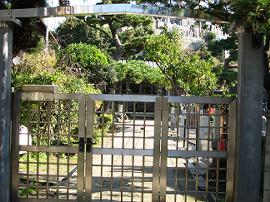
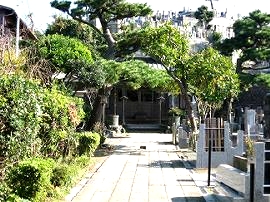
The temple was founded in 1309 by Nikken (日賢), a disciple of Nichiren (日蓮, 1222-82). The Main Hall contains a sambo-soshi (三宝祖師) and a statue of Nichiren.
| Kangyoji (勧行寺) |
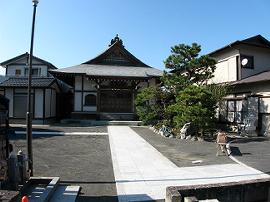
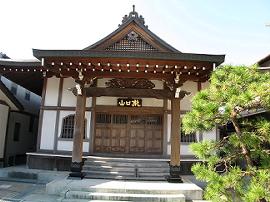
This temple was built in 1303 by Nichijitsu (日実). The chief image in the Main Hall is a sambo-soshi. There is also a statue of Monju Bosatsu that was plucked from the waters of Sagami Bay by a young man of the neighborhood and brought here.
| Myotenji (妙典寺) |
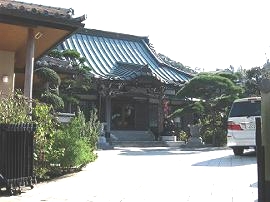
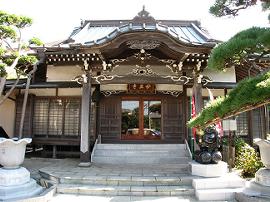
The temple was created in 1313 (or 1308) by Temmoku (天目), a disciple of Nichiren. In the Main Hall are a sambo-soshi and a statue of Nichiren.
| Tozenji (東漸寺) |
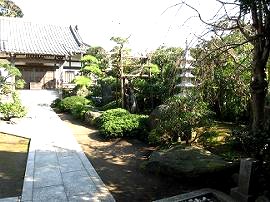
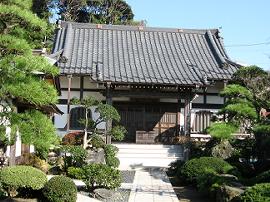
The temple was founded in 1352 by Nitto (日東), who was dispatched from Hokekyoji Temple (法華経寺) in Nakayama (中山), Chiba. The Main Hall houses statues of Nichiren and Shaka Nyorai (釈迦如来). The gate is in the yakuimon-style (薬医門).
| Honryuji (本龍寺) |
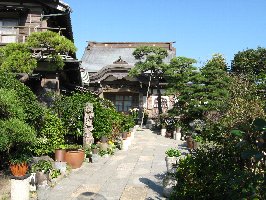
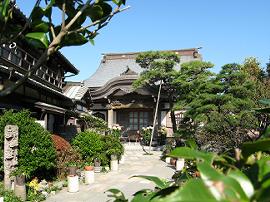
Built in 1302 by Nichigyo (日行), this temple lays claim to being the first founded among the eight temples in this system. The Main Hall contains a sambo-soshi, a statue of Nichiren showing him praying for rain, and statues of Daikokuten (大黒天), Kishimojin (鬼子母神), Jurasetsunyo (十羅刹女, ten female goblins, who later became protectors of the faithful in Hokekyo, 法華経, the Lotus Sutra), and Nichigyo himself.
| Hozenin Temple (宝善院) |
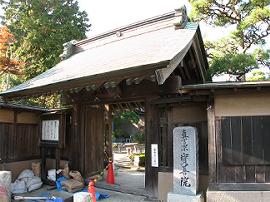
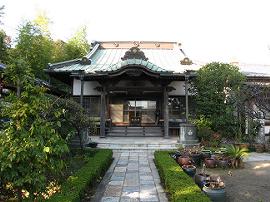
Hozenin Temple is located in the neighborhood of Koshigoe Chugakko (腰越中学校). The sango is Kajisan (加持山), and the temple belongs to the Shingon sect (真言宗). Taicho (泰澄, 687-767), said to have been the most virtuous priest in Echigo (越後, present-day Niigata Prefecture) in those days, is credited with the founding of the temple. The gate is in the yakuimon-style. The Main Hall houses statues of Yakushi Nyorai (薬師如来) and Juichimen Kannon (十一面観音). Within the grounds is a hall called Taishido (大師堂).
| Hogenji Temple (法源寺) |
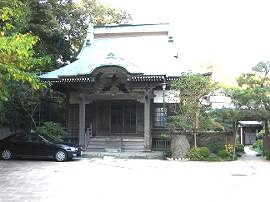
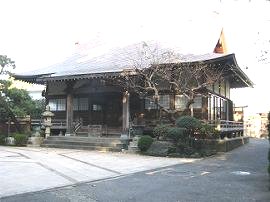
Hogenji Temple is also in the neighborhood of Koshigoe Chugakko. The temple was created in 1318 by Nichigyo. The Main Hall houses a sambo-soshi and a statue of Nichiren. Monjudo (文殊堂), another hall, contains a statue of Monju Bosatsu (文殊菩薩). A nickname for this temple is Botamochi-dera (ぼたもち寺), botamochi being a rice cake covered with sweetened bean paste. The story behind this nickname is the same as the story told by Joeiji Temple (常栄寺) in Omachi. A lady by the name of Sajikini (桟敷尼) made an offering of botamochi, praying that Buddha would protect Nichiren on that fateful day (September 12) in 1271 when he was led off to the execution grounds at Tatsunokuchi (竜ノ口) near Enoshima. (See Joeiji Temple)
| Tatsunokuchi (龍ノ口) |
The area near Ryukoji Temple is called Tatsunokuchi, literally, "Dragon Mouth," because the shape of the hills from Fukasawa (深沢) to Tatsunokuchi resembled a reclining dragon (ryu or tatsu, 龍) and this spot corresponded to its mouth, kuchi (口). This geographic feature may also have brought about the legend of a five-headed dragon associated with Benzaiten on Enoshima Island. Others say that a river from Lake Fukasawa had five branches ,which resembled a five-headed dragon. This area now belongs to the city of Fujisawa, but in olden days was part of Koshigoe, which is in Kamakura.
| Ryuko Myojinsha (龍口明神社) |
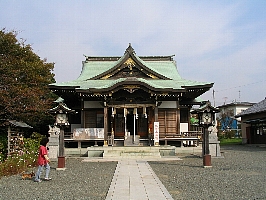
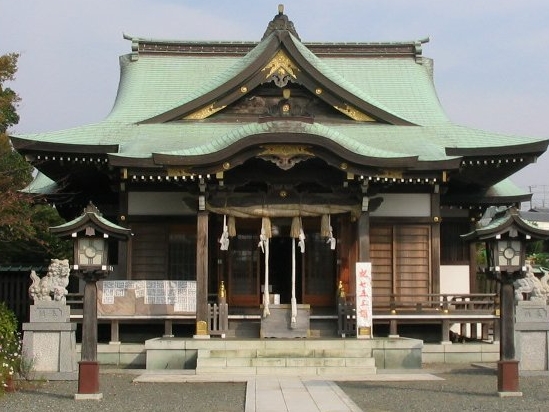
Location: The shrine is situated approximately 400 meters from Nishi-Kamakura Station on the Shonan Monorail Line and is relatively new, having been moved here in 1978.
Grounds and History: The approach, on slightly raised and graveled ground, has two myojin-style torii, or shrine gates, dedicated to Tamayori Hime no Mikoto (玉依姫命), and the shrine houses a statue of a five-headed dragon (gozuryu, 五頭龍), with a statue of Shirahige Myojin (白髭明神) standing in front of it.
Story:
A story handed down over the centuries tells of a five-headed dragon that would appear and cause disasters of many kinds to the local people. It would damage crops and even devour children.
However, somewhere around the year 550 when the dragon came to the village as usual, dark clouds gathered above the southern sea, ear-splitting rolls of thunder were heard, and violent winds and raging waves were seen.
A golden ray of light then appeared above the clouds and approached the dragon. The light was Benzaiten, attended by two child attendants. Dirt and sand began showering from the sky and a section of the bottom of the sea rose, forming the island we now know as Enoshima.
So beautiful was Benten that the dragon proposed to her. Her indignant reply was, "The welfare of the people is what is first in my mind. Who would accept a proposal from a villain such as you?" Deeply repentant, the dragon said, "I have behaved badly but promise to do my best from now on for the safety and happiness of the people." Benzaiten thereupon accepted his proposal and they wed.
The dragon then helped the people and came to be loved by them in return. Upon his death his body turned into the mountain that extends from Fukasawa to Tatsunokuchi and people in Tsu, praising his virtue, built a shrine dedicated to him.
Festival
The shrine's annual festival is held on the first Saturday and Sunday of October. Once every sixty years in April, the shrine also holds a special celebration in conjunction with an observance that is held at Enoshima Jinja Shrine.
| Ryukoji Temple (龍口寺) |
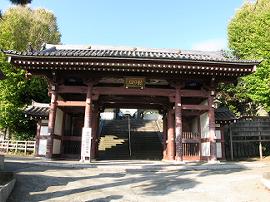
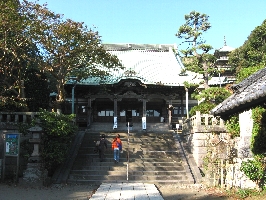
Full name: Jakukosan (寂光山) Ryukoji (龍口寺)
Denomination: Nichiren sect (日蓮宗)
Location: Located near Enoshima Station on the Enoden Line
History:
Nichiren (日蓮, 1222-82) is closely associated with this site and the founding of the temple.
On September 12 in 1271, he was slated for execution, for he had been blaming all the other Buddhist sects for the famines, diseases, earthquakes and other disasters the people had been suffering from.
He had even gone so far as to criticize the government. On the day of his scheduled execution, while sitting on the stone that was to be his death seat, he began to chant a sutra. His followers did likewise, breaking into tears. Nichiren reproved them, saying, "It is a pleasure to sacrifice oneself for the true doctrine, is it not? Why, then, do you not keep your promise of not getting upset?"
When the executioner, Echi no Saburo (越智三郎), raised his sword, a flash of lightning raced across the sky. The officials, dazzled by the flash, were frightened and fled. The execution was cancelled and a report was made to the government. The event is referred to as "The Tatsunokuchi Persecution (龍ノ口の法難)."
In 1337, Nippo (日法), a priest, carved a statue of Nichiren and built a hut for it to commemorate this miraculous event and his master's virtue. Thus the temple was created.
Nisson (日尊), another priest, then initiated the building of a real temple and Shimamura Uneme (島村采女), a believer who resided in the Tsu area, donated the land.
Grounds: Entrance to the temple is gained via the imposing Niomon Gate (仁王門). After you pass through it, a stone stairway will take you up to the Sammon Gate. The Main Hall stands beyond the spacious grounds.
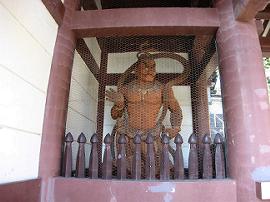
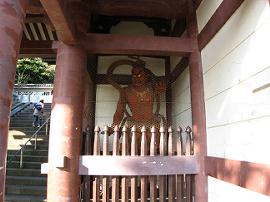
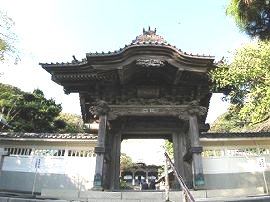
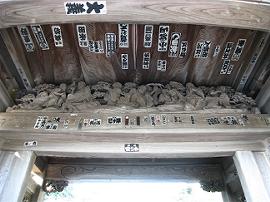
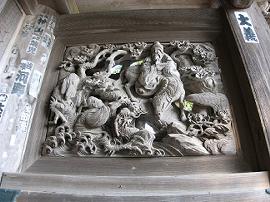
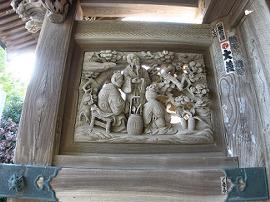
The Main Hall was remodeled in 1818 and 1832, the Sammon Gate with its elaborate carvings was built through donations from the Konoike (鴻池) family (a major merchant house in Osaka during the Edo period) and the five-story pagoda (五重塔), completed in 1910, is another treasure that has survived over the years. Immediately to the left after the Sammon Gate is a hall called Myokendo (妙見堂), and at the top of the stone stairway and immediately to its left is Jogyodo Hall (浄行堂), dedicated to Jogyo Bosatsu (浄行菩薩).
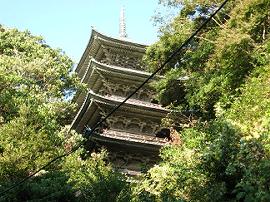
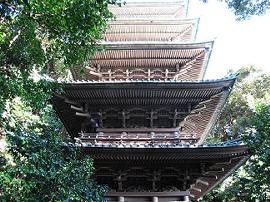
At the foot of the nearby cliff is a cave called Shonin Honan Toya Goippaku no Reikutsu (上人法難当夜御一泊の霊窟), in which Nichiren took a night's rest after he was pardoned. The cave is said to have been an ancient burial cave dug horizontally in a cliff.
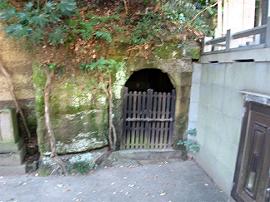
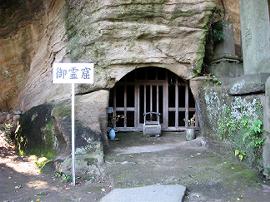
To the right of the Main Hall is a statue of Nichiren. In front of the statue are the belfry and Daishoin (大書院).
On higher ground to the left is Shichimendo Hall (七面堂), or Seven-sided Hall, and at the top of the hill is a white Bussharito (仏舎利塔), pagoda said to contain a relic of Buddha. To the left of Niomon Gate is a monument to mark the site where Nichiren's execution was to have taken place. Shikikawa-ishi (敷皮石), the stone on which he is said to have sat for his execution, was moved from here to the Main Hall.
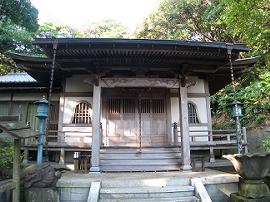
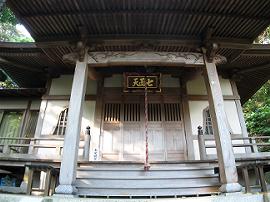
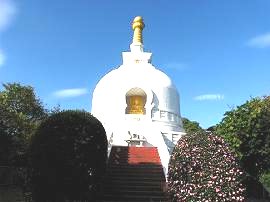
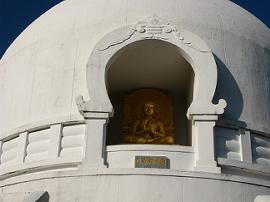
A memorial service for Nichiren is held from September 11 to 13 on the anniversary of the persecution. Believers and non-believers alike gather in the grounds to praise the priest's courageous behavior and his virtue.
| Joryuji Temple (常立寺) |
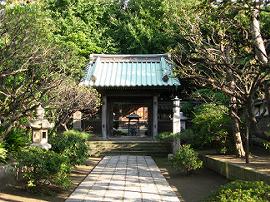
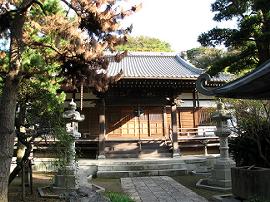
Full name: Ryukozan (龍口山) Joryuji
Denomination: Nichiren sect (日蓮宗)
Location: The temple is located near Shonan-Enoshima Station on the Shonan Monorail Line.
History: Tatsunokuchi was once an execution site, and the bodies of the executed were buried here. Stupas were erected for the repose of their souls. A priest by the name of Nichigo (日豪) founded the temple in the early 1500s, and somewhere between 1573-1592 it was restored by Nissei (日政).
Grounds: Joryuji Temple is well-known as the burial grounds for the five messengers who were sent from the Mongol empire. Their tombs, called Genshizuka (元使塚), are five gorinto-type (五輪塔) stupas.
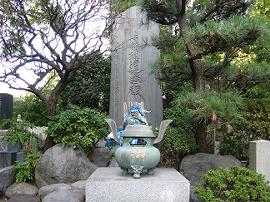
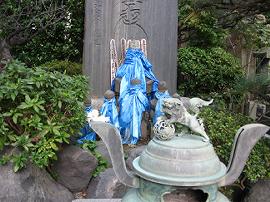
The messengers had come to Japan in 1275 carrying a message from Kub(i)lai Khan demanding surrender. Hojo Tokimune (北條時宗, 1251-84), the eighth regent, rejected the demand and had the five messengers beheaded. The leader of the messengers was To Seichu (杜世忠, 1242-75). The execution was performed at the Tatsunokuchi execution grounds.
To the right behind Sammon Gate stand six statues of Roku Jizo (六地蔵). The Main Hall houses several stone tablets (itabi, 板碑) brought here when a nearby road was constructed.
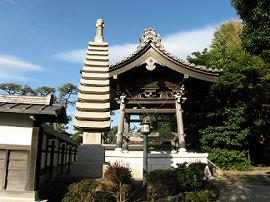
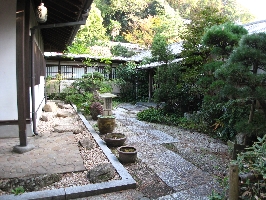
| Honrenji (本蓮寺) |
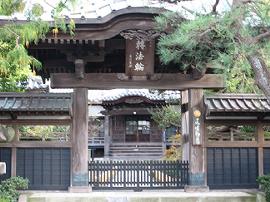
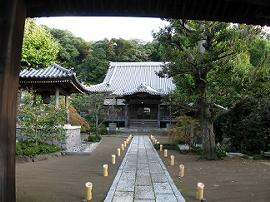
Full name: Ryukozan (龍口山) Honrenji
Denomination: Nichiren sect (日蓮宗)
Location: Honrenji Temple is located in the same neighborhood as Joryuji.
History: The temple claims to have been founded in 595 by Gigen (義玄). He was a disciple of Eji (恵慈) who, in 595, came from Korea and gave religious instruction to Shotoku Taishi (聖徳太子, 574-622). Thereafter, such celebrated priests as Taicho, Kukai (空海, 774-835), and Jikaku (慈覚, 794-864, a.k.a. Ennin, 円仁), are said to have stayed here.
Nisshu (日秀) converted the temple to the Nichiren sect in 1271. He had been greatly impressed by Nichiren, who, while staying here after his pardon at Tatsunokuchi, brought about a miraculously easy childbirth for the wife of a wealthy man in this area.
Grounds In the Main Hall are sambo-soshi, and a statue of Nichiren called Koyasu Nichiren (子安日蓮) that is worshiped in connection with the above-mentioned easy childbirth.
Within the grounds is a belfry, and on the hill at the back of the Main Hall is a white Shaka Tahoto (釈迦多宝塔), which houses a seated wooden image of Shakyamuni (釈迦牟尼).
(Please make sure whehter the temple is close to public view when you visit.)